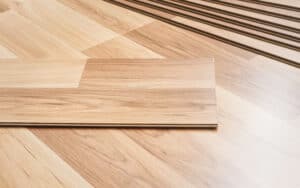
If you’ve considered replacing the tiles in your bathroom, you know you need a few tools.
You need the tiles themselves, a spreader, and a tile mortar.
The type of tile mortar that you buy can determine how well your tiles stick to the surface and how long you need to wait for the mortar to dry.
Since you shouldn’t walk on the tiles while the mortar is drying, you may wonder how long you have to wait.
How Long Does Tile Mortar Take To Dry?

It can take tile mortar anywhere from 24 hours to 48 hours to dry.
Certain factors can decrease or increase the time it takes for the mortar to dry and cure.
During the drying or curing process, it’s best not to step on the tiles.
As such, if you need to use the area where you’re tiling, it’s a good idea to do it in sections.
This allows you to access certain parts of your bathroom, for example, without disturbing the curing process.
If what you’re doing in the bathroom involves water, it’s a good idea to cover your tiles first.
You can remove the cover when you’re done.
If you fail to let your mortar cure, it can result in cracked or loose tiles.
You might have to reapply the mortar and start again.
When Can You Walk On New Tiles?

You shouldn’t walk on the newly-adhered tiles for 24 hours.
Essentially, once you spread mortar on the tiles and place them down, you’ll want to avoid stepping on any tiles until the drying process finishes.
If you step on the tiles before that process ends, you might face a few problems.
First, it can disturb the even spreading of the mortar.
Instead, your weight might cause the mortar to squish out at the ends of the tile.
The tile may fail to adhere to the surface because it doesn’t have any mortar sticking to it at its center.
As a result, you may notice your tiles are loose.
Stepping on it can also result in an uneven floor.
Since mortar can give tiles a bit of lift, if you step on it before it dries, it might make the tile sink in a bit.
As a result, you might have a few areas that are lower than the others.
Besides being unsightly, it can cause some problems with water collection.
As such, it’s a good idea to let tile mortar dry entirely before you start walking on the tiles.
How Long Should Mortar Set Before Cleaning?

Once you set down your tiles after applying mortar, you may be looking at a big mess.
Mortar is messy, and if it’s peeking out between gaps or on top of tiles, you might feel the need to clean it off.
However, you should still wait 24 to 48 hours before cleaning your tiles.
That’s because you still need to wait for the mortar to cure.
If you start cleaning the tiles before the mortar sets, you could face a few problems.
For one, you might apply pressure to the tiles while you’re cleaning.
You might lean on a tile to support your weight while you’re scrubbing the tile or the gap between the two tiles.
Applying pressure to tiles that haven’t set yet can cause problems.
Cleaning can also ruin the mortar.
If you’re using bleach or some other sort of cleaner, it might mix with the uncured mortar.
That could impede the mortar’s ability to dry or make it take longer to dry.
Using water on unset tiles can increase the amount of time it takes for the mortar to dry.
Even if the gaps look dry, the mortar beneath the tile may not have dried yet.
Since it doesn’t receive as much air as the gaps do, it takes longer to dry.
As such, you should wait a full day or two before cleaning your tiles.
Why Is My Tile Mortar Not Drying?

While tile mortar typically takes anywhere from 24 hours to 48 hours to dry, you may find that yours is taking longer than that.
You might wonder if something is wrong with the mortar, or if there’s an external problem causing it not to dry.
Here are a few reasons your tile mortar might not be drying.
1. You Used Pre-Mixed Thinset

There are several types of mortar that you can use for your tiles.
One example is pre-mixed thinset.
The advantage of using a pre-mixed thinset is that it’s essentially ready for you to use right out of the box.
You’re able to start applying it to your tiles right away.
This makes it ideal for those who aren’t comfortable with ratios or mixing mortar well.
The problem with pre-mixed thinset is that it can take a very long time to dry.
The fastest it dries is typically 24 hours.
However, it can also take 72 hours or even several weeks to fully dry.
Its drying process can also depend on certain environmental factors.
As such, while the application process might be a bit more convenient, the drying process is not.
If you can’t afford to wait weeks for your mortar to dry, you might not want to use pre-mixed thinset.
2. The Humidity Is High

Another problem that can impact how fast your tile mortar is drying is humidity.
If you live in a climate where humidity is high, it’s going to take your tiles a bit longer to dry.
That’s because all the moisture in the air is essentially keeping the mortar moist as well.
You might find that tiling during a rainy or humid day can prevent your mortar from drying.
As such, you can potentially speed up the process by using a dehumidifier to remove some of the moisture in the room.
You’ll also want to close any windows and keep from using appliances like the sink or shower to try and limit the humidity.
By removing the humidity in the room, you can make the drying process a bit faster.
3. Your Tiles Aren’t Porous

Porosity also plays a factor in how fast your tile mortar dries.
You may notice that your tile mortar isn’t drying because you’re using ceramic tiles or other man-made tiles.
Man-made tiles either have no porosity or very little porosity unless they’re specifically made for that purpose.
As such, when you use ceramic tiles, the lack of porosity makes the mortar take longer to dry.
That’s because the tile isn’t going to have air passing through it.
It can only rely on the joints and the underlayment for airflow.
It receives less air, so it dries slower.
Natural stone, on the other hand, is porous.
The porosity allows the tile to have air pass through its face.
Since it’s receiving more air, it takes less time for the mortar to dry.
You may notice your mortar isn’t drying because you’re using ceramic or other man-made tiles.
4. Small Grout Joints

A final reason your tile mortar may not be drying is that you have small grout joints.
The joints are one of the primary ways in which mortar dries.
Air passes through the joint and dries the mortar.
If the grout joints are small, it means there’s less air passing through the joint and drying the mortar.
If the tile is also made of ceramic, the drying process can take even longer.
Wider grout joints, on the other hand, tend to make the drying process faster.



Leave a Reply